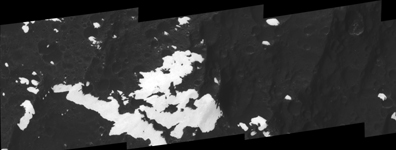Towering Peaks of Iapetus

Figure 1
This stereo image, or anaglyph, shows huge mountains on Saturn's moon Iapetus, imaged by NASA's Cassini spacecraft during its very close flyby in Sept. 2007. These mountains are located at the moon's equator in the westward-most part of the dark terrain.
Here, the brightness pattern on the surface is very complex. The mountain in the center of this view is part of the range informally named "the Voyager mountains" that were first detected on the limb of the moon in NASA Voyager spacecraft images. Interestingly, its eastern (right) flank is dark, while the other flanks are bright. This suggests that external material arriving on Iapetus from its orbital motion might play a role in the darkening process. One plausible source, the outer moons of Saturn, might provide a very thin but steady stream of very dark particles from the eastern direction as seen from this mountain.
The mosaic consists of six image footprints across the surface of Iapetus. The view is centered on terrain near 0.1 degree north latitude, 199 degrees west longitude. Image scale is approximately 46 meters (151 feet) per pixel.
The clear spectral filter images in this mosaic were obtained with the Cassini spacecraft narrow- angle camera on Sept. 10, 2007. Distances for the blue portion of the image range from 7,744 to 9,135 kilometers (4,812 to 5,676 miles) from Iapetus; distances for the red portion of the image range from 20,267 to 21,595 kilometers (12,593 to 13,418 miles) from the moon.
A separate, non-stereo version of the scene is included for comparison (figure 1).
Iapetus is 1,468 kilometers (912 miles) across.
The Cassini-Huygens mission is a cooperative project of NASA, the European Space Agency and the Italian Space Agency. The Jet Propulsion Laboratory, a division of the California Institute of Technology in Pasadena, manages the mission for NASA's Science Mission Directorate, Washington, D.C. The Cassini orbiter and its two onboard cameras were designed, developed and assembled at JPL. The imaging operations center is based at the Space Science Institute in Boulder, Colo.
For more information about the Cassini-Huygens mission visit http://saturn.jpl.nasa.gov/home/index.cfm. The Cassini imaging team homepage is at http://ciclops.org.
